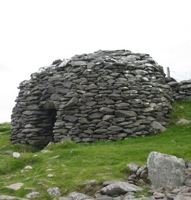Difference between revisions of "Hut"
(Created page with 'File:lighterstill.jpgright|frame ==Etymology== French hutte, from Old French hute, from Old High German hutta hut; probably akin to [http://nordan.daynal.or...') |
m (Text replacement - "http://" to "https://") |
||
| (One intermediate revision by the same user not shown) | |||
| Line 2: | Line 2: | ||
==Etymology== | ==Etymology== | ||
| − | French hutte, from Old French hute, from Old High German hutta hut; probably akin to [ | + | French hutte, from Old French hute, from Old High German hutta hut; probably akin to [https://nordan.daynal.org/wiki/index.php?title=English#ca._600-1100.09THE_OLD_ENGLISH.2C_OR_ANGLO-SAXON_PERIOD Old English] hȳd skin, hide |
| − | *Date: [ | + | *Date: [https://www.wikipedia.org/wiki/17th_Century 1655] |
==Definitions== | ==Definitions== | ||
*1 : an often small and temporary dwelling of simple construction : shack | *1 : an often small and temporary dwelling of simple construction : shack | ||
| Line 12: | Line 12: | ||
Huts are used as temporary [[shelter]] by people. Huts are quickly built of [[natural]] materials such as ice, stone, leather, fur, grass, palm leaves, branches and/or mud and exist in [[practically]] all [[nomadic]] [[cultures]]. Some huts are easily transportable. | Huts are used as temporary [[shelter]] by people. Huts are quickly built of [[natural]] materials such as ice, stone, leather, fur, grass, palm leaves, branches and/or mud and exist in [[practically]] all [[nomadic]] [[cultures]]. Some huts are easily transportable. | ||
| − | Huts are used by [ | + | Huts are used by [https://en.wikipedia.org/wiki/Shepherd shepherds] when moving livestock between [[seasonal]] grazing areas such as [[mountain]]ous and lowland pastures (transhumance). Some displaced [[populations]] of people use huts throughout the world during a diaspora. For example; temporary collectors in the [[wilderness]] [[agricultural]] workers at plantations in the Amazon jungle. Huts have been built for [[purposes]] such as storage, workshops, and [[teaching]]. |
| − | The term has also been [[adopted]] by climbers and backpackers to refer to a more solid and permanent [[structure]] offering refuge. These vary from simple [ | + | The term has also been [[adopted]] by climbers and backpackers to refer to a more solid and permanent [[structure]] offering refuge. These vary from simple [https://en.wikipedia.org/wiki/Bothy bothies] - which are little more than very basic [[shelters]]; to [[mountain]] huts which are far more luxurious and can even include facilities such as restaurants. |
==See also== | ==See also== | ||
*'''''[[Shelter]]''''' | *'''''[[Shelter]]''''' | ||
| − | *'''''[ | + | *'''''[https://en.wikipedia.org/wiki/Vernacular_architecture Vernacular architecture] |
[[Category: Architecture]] | [[Category: Architecture]] | ||
Latest revision as of 23:56, 12 December 2020
Etymology
French hutte, from Old French hute, from Old High German hutta hut; probably akin to Old English hȳd skin, hide
- Date: 1655
Definitions
- 1 : an often small and temporary dwelling of simple construction : shack
- 2 : a simple shelter from the elements
Description
A hut is a small and crude shelter, usually used for dwelling. Its design favors local techniques and materials to allow for swift and inexpensive construction.
Modern use
Huts are used as temporary shelter by people. Huts are quickly built of natural materials such as ice, stone, leather, fur, grass, palm leaves, branches and/or mud and exist in practically all nomadic cultures. Some huts are easily transportable.
Huts are used by shepherds when moving livestock between seasonal grazing areas such as mountainous and lowland pastures (transhumance). Some displaced populations of people use huts throughout the world during a diaspora. For example; temporary collectors in the wilderness agricultural workers at plantations in the Amazon jungle. Huts have been built for purposes such as storage, workshops, and teaching.
The term has also been adopted by climbers and backpackers to refer to a more solid and permanent structure offering refuge. These vary from simple bothies - which are little more than very basic shelters; to mountain huts which are far more luxurious and can even include facilities such as restaurants.
